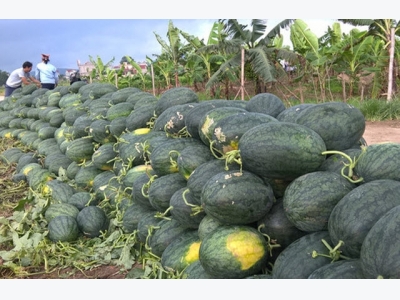As Chinese stop importing fruit, farmers look to domestic market

As many Vietnamese farmers are reliant on the Chinese market, they have suffered as Chinese traders have reduced fruit imports.
In 2015, Vietnam ranked third among the five biggest vegetable & fruit producers in SE Asia. However, Vietnam’s fruit exports have been too reliant on dragon fruit and the the Chinese market.
A report of Fine Fruit Asia showed that 82 percent of Vietnam’s fruit export value comes from dragon fruit, while 91 percent of the demand is from China. But China is an extremely unstable market.
Most of the Chinese buyers are intermediary merchants who collect fruits irregularly. The exports will be more stable only if Vietnamese exporters can approach Chinese businessmen who distribute products directly to consumers.
Most of the Chinese buyers are intermediary merchants who collect fruits irregularly. The exports will be more stable only if Vietnamese exporters can approach Chinese businessmen who distribute products directly to consumers.
Chinese merchants often stop importing fruit, leaving farm produce unsold.
Therefore, ministries and branches have to call on domestic consumers to buy the unsold products to rescue farmers who have produced bananas, dragon fruit, water melon and pork.
Local newspapers have shown images of trucks laden with fruits getting stuck at the border gates as China was importing products in limited quantities.
Nigel Smith, CEO of Fine Fruit Asia, said at a workshop held several days ago that it is the heavy reliance on one product and one market which has affected Vietnam’s agriculture.
Meanwhile, the domestic market is not well organized, with big problems in the distribution channel. This is why farmers have to sell pigs at very low prices while consumers have to buy pork at high prices.
Households, which organize production on a small scale, remain the major production force in Vietnam’s agriculture. This leads to unstable relations between producers and exporters.
As a result, exporters mostly target markets which set low requirements instead of choosy markets such as Japan, the US and Europe.
According to Le Van Duc from MARD, temperate countries such as China, South Korea and Japan have crops from spring to September, so the ministry has advised farmers to harvest products from October to March.
However, as farmers develop crops, they also harvest farm produce at a time when Chinese farmers have their crops, thus leading to an oversupply.
MARD has asked Binh Thuan province, which is the ‘dragon fruit metropolis’, to work with some other localities, to discuss the solutions of growing dragon fruit at different times to avoid massive harvesting and oversupply.
In the long term, he said Vietnamese farmers need to improve the quality of their farm produce so they can enter choosy markets.
Có thể bạn quan tâm
 New generation corn turns around countryside poverty
New generation corn turns around countryside poverty Vietnamese farmers are getting rich by applying science and technology to their plantations.
 Cashew production forecast to drop nearly 20 percent in 2017
Cashew production forecast to drop nearly 20 percent in 2017 Vietnam is expected to harvest only 0.87 tonnes of cashew nuts per ha in 2017, 0.21 tonnes or nearly 20 percent less than 2016’s output per ha
 Bottlenecks in rice production chain affecting market share
Bottlenecks in rice production chain affecting market share Vietnam’s rice production is meeting difficulties because of two bottlenecks at the ends of the production chain, leading to a decline in market share.